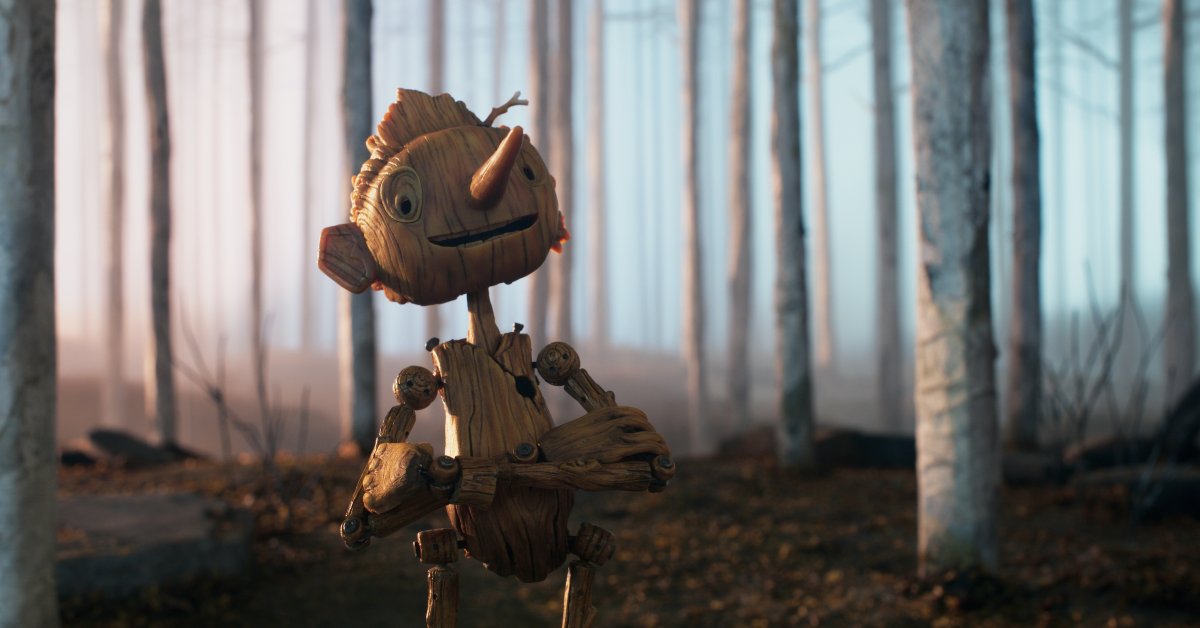Guillermo del Toro’s love for misunderstood creatures—for those who creep forth from the Black Lagoon or spring from the operating table of Dr. Frankenstein—is one of his signatures as a filmmaker, and his stop-motion-animated version of Pinocchio introduces us to a particularly unruly soul made of wood. When this Pinocchio bounds to life, bouncing off Gepetto’s worktable after a woodland fairy performs a not-fully thought-out spell, he’s an agent of chaos, stumbling around on his stiltlike legs, ablaze with wonder at the newness of everything around him. He holds drinking glasses up to his eyes like binoculars, before tossing them over his shoulder with a crash; he zealously attacks a cuckoo clock, yanking out its sweetly carved wooden bird and sending it flying. He’s the ultimate nightmare toddler, the kind who makes parents look at one another and ask, “How did we create such a menace?” But he’s also a creature born of grief. In this Pinocchio, the unassuming woodworker Gepetto has lost a real-life son in a wartime bombing. The puppet he creates, carving him from the trunk of a particularly beloved tree, isn’t meant to be a substitute, or is he? Either way, this is not the son he wants—though maybe, like the Rolling Stones said, it’s the one he needs.
In this meticulously crafted picture—its full and proper name is Guillermo del Toro’s Pinocchio, to distinguish it from all the other versions, and del Toro co-directed it with Mark Gustafson—everybody has something to learn about life. That’s what gives the movie both its sweetness but also its heavy molasses aftertaste. This loose retelling of Carlo Collodi’s weird and often unsettling 1883 fantasy novel (the screenplay is by del Toro and Patrick McHale) is a little too long, and hammers away too eagerly at its central idea: that fathers who expect too much of their sons can do untold emotional damage. Even so, del Toro’s creation is clever and lively and just strange enough to keep you guessing what’s coming next. And if the character design is sometimes offputtingly creepy—some characters, even ones we’re supposed to like, have enormous, human-looking eyes staring glassily out of their oversized heads—Pinocchio himself, with his knotty-pine textured body and Butch Waxed-wooden cowlick, has a kind of bratty appeal. He’s the star of this show, and he milks it.
Gepetto (voiced by David Bradley) and Pinocchio (voiced by Gregory Mann) in Guillermo del Toro’s Pinocchio
Courtesy of Netflix
Del Toro has reframed the story as a parable opening in World War I Italy, with fascism on the rise. Gepetto (voiced by David Bradley) loses his flesh-and-blood son, Carlo (Alfie Tempest), when a bomb hits the local church, where the boy is helping his father finish the carving of a crucifix. The heartbroken Gepetto plants a tree from the perfectly shaped pinecone the boy had scooped up just before his death; it grows over the years, but Gepetto’s sorrow doesn’t abate. In a drunken blur, he cuts down the tree—temporarily rattling the brains of the story’s narrator, the cricket Sebastian (Ewan McGregor), who has taken up residency inside—and creates a puppet boy in a feverish nighttime work session. While Gepetto sleeps, a blue-tinged wood sprite in a feathered turtleneck (Tilda Swinton) grants the gift of life to Pinocchio (Gregory Mann), with the aim of restoring Gepetto’s joie de vivre.
It doesn’t work out that way, at least for a while. The local Podestá (Ron Perlman), already a fascist flunkie, catches wind of this dangerously autonomous puppet and warns Gepetto that he’d better keep this little faux boy in line. Of course, that’s impossible. Instead of going to school, Pinocchio runs off with the evil showman Count Volpe (Christoph Waltz) and his seemingly sinister monkey assistant Spazzatura (Cate Blanchett), a hunched mischief-maker with red-rimmed eyes and a disgruntled pout. (Spazzatura means trash in Italian, and Volpe’s name is surely a nod to Giuseppe Volpi, the Italian count who led the National Fascist Party, two examples of del Toro’s gift for the playful touch.) But even the assertively naughty Pinocchio begins to crave human affection, and if Gepetto at first finds it hard to love his willful little creation, the cricket Sebastian sets him straight. The old man begins to feel some sympathy for his boy made of bois, and sets out to find him.
Read More: The 10 Best Movies of 2022
Del Toro excises some of Collodi’s kookier plot turns (no one here ever turns into a donkey) and invents some new twists (as when Pinocchio is sent off to be trained as a soldier). Tilda Swinton’s benevolent wood sprite also has a more ambiguous twin, who lives in the afterworld, with a group of poker-playing rabbits as her underlings. Nothing in this Pinocchio is as simultaneously enchanting and unsettling as the worlds del Toro built for us in his early-career masterpieces The Devil’s Backbone and Pan’s Labyrinth, or as inventively joyful as his Hellboy movies. And roughly two-thirds in, the movie begins to feel a bit cluttered and unwieldy. But it’s a pure vision nonetheless—del Toro’s fingerprints are clearly visible in this painstakingly carved creation. As a filmmaker, he shows an admirable mix of ambition and humility, and you never know what he’s going to summon from his worktable. This time, it’s a mad wooden boy who wins us over in the end.
More Must-Reads From TIME



